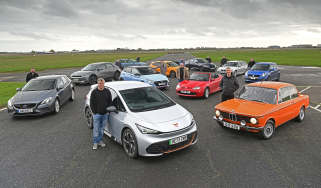Volkswagen Golf R DSG
New stability control system promises more fun for keen drivers. We head to the Arctic to test it out.

The Golf R remains a capable if somewhat costly hot hatch that offers a distinct performance advantage over the GTI. The firm’s new stability control system offers the choice and freedom to explore the car’s limits that enthusiastic drivers look for, without losing the obvious safety benefit the system delivers in day-to day motoring. However, it’s a shame that the excellent ACC active damping system still isn’t’ standard in this over-£30,000 Golf. Nonetheless, keen drivers will welcome the fact that all Sciroccos, Golf GTIs and the Golf R will have this revised stability system as standard from May.
Listening to your customers is important in any business and that’s clearly a principle Volkswagen subscribes too. Despite the success of its sporty models, the firm says that feedback from owners and comments from journalists that stability control systems take the edge off driver enjoyment has meant the firm’s engineers have developed new software for all Golf R and GTI models, plus the entire Scirocco line-up.
Clearly, no one is disputing the safety benefits of stability control so as you would expect the system is unchanged in its default setting. However, on the right road or on track, the racy Volkswagens now allow you to turn off the electronic assistance in two stages. Stage one shuts off the traction control, but retains the skid preventing stability element.
Used - available now

2023 Peugeot
2008
22,018 milesManualPetrol1.2L
Cash £14,400
2023 MG
MG4 EV
17,467 milesAutomaticElectric
Cash £13,224
2022 BMW
X1
18,704 milesAutomaticPetrol1.5L
Cash £21,997
2022 BMW
3 Series Touring
60,597 milesAutomaticPetrol2.0L
Cash £19,687Hold the button down for three seconds and this is disabled as well. Previously, enthusiastic drivers who took their Volkswagens up to the grip limit would have felt the stability control applying the brakes to control any slide, but now the chassis is being given the freedom to engage a bit more.
The revised system allows for the car to move about and give a more a natural feedback, any counter steering or throttle modulation won’t rearm the stability control, however if you touch the brake whilst the car is under load the system will then intervene.
In snowy conditions of our artic test, the revisions meant that in the four-wheel drive Golf R you could feel the drivetrain transferring power from the front to rear axle in response to grip level and driver inputs more than you could with the old system. This purer driving experience adds some appeal to VW’s flagship performance car.
It also allows the car to be used for driver training, with the person at the wheel able to learn what causes, and how to correct, understeer and oversteer. Volkswagen has no plans to offer this system on mainstream models, but by offering it on the cars likely to appeal to enthusiasts it has added an extra level of credibility and desirability to its sporty offerings.



